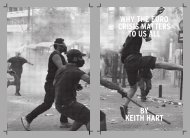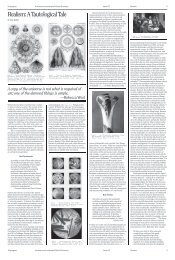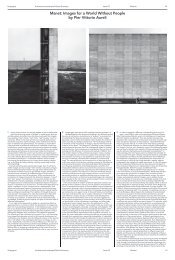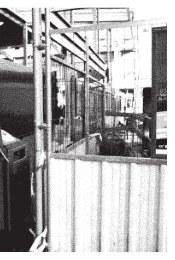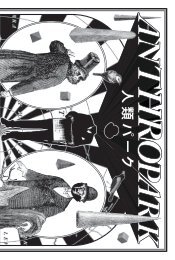Full Issue - Scapegoat
Full Issue - Scapegoat
Full Issue - Scapegoat
Create successful ePaper yourself
Turn your PDF publications into a flip-book with our unique Google optimized e-Paper software.
<strong>Scapegoat</strong> Architecture/Landscape/Political Economy<br />
<strong>Issue</strong> 01 Service<br />
23<br />
Where Art Belongs<br />
Chris Kraus, Semiotext(e), 2011, 171 pp.<br />
Reviewed by Emily Stoddart<br />
Where does art belong? And, should we<br />
care? The French theorist Jean Baudrillard<br />
wrote The Conspiracy of Art 15 years ago,<br />
and the text ushered in a comportment of<br />
skepticism toward art practice by aligning<br />
art production with the takeover by capitalism.<br />
1 For many critical readers, a theory of<br />
art stems from other readings about art,<br />
the result of a prevailing distrust toward<br />
any material production. To confront an art<br />
object without such theoretical buffers is<br />
rare. Presumably, in many intellectual circles,<br />
art belongs to art theory and thus runs the<br />
natural and inevitable risk of getting raped<br />
by the art market. In Where Art Belongs,<br />
the eighth in Semiotext(e)’s Intervention Series<br />
of small but urgent books, Chris Kraus<br />
offers a provocation on the subject in question—and<br />
deftly sidesteps an answer. But<br />
what her work is not is deliberate conspiracy<br />
theory. While it may be an assumed requirement,<br />
Where Art Belongs has no manifesto,<br />
and Kraus avoids an explicit condemnation<br />
of capitalism or art production. She offers<br />
no rallying cry. Rather, using a similar style<br />
of reportage applied in her last book, Video<br />
Green: Los Angeles Art and the Triumph<br />
of Nothingness (2004), Kraus writes for and<br />
about the contemporary art scene. There is<br />
narrative integrity, however. By emphasizing<br />
the self through her repetitive use of<br />
the first-person pronoun, Kraus actually<br />
pinpoints the “truth” of contemporary artmaking<br />
via the truism of “self-help”—<br />
a manual mindset for modern times. Being<br />
both unnecessary and subjective, she<br />
brilliantly exploits her intellectual platform<br />
to create an extremely contemporary, and<br />
politically driven, text-based work of art.<br />
Beginning with the essay “Tiny Creatures,”<br />
Kraus describes in great detail the<br />
activity of Janet Kim and friends as they<br />
mount and subsequently take down a<br />
successful arts space in the now-gentrified<br />
Echo Park neighbourhood of Los Angeles.<br />
Describing the venture from its meager<br />
beginnings to its rise—and eventual downfall—as<br />
coveted art world hotspot, Kraus<br />
incorporates the various manifestos written<br />
by Kim to declare the mandate of the space<br />
while revealing its temporality. Using avantgarde<br />
structures and theory for traction,<br />
Kraus expounds on political philosophical<br />
references while purposely embracing the<br />
daily activity of Kim. The essay has no real<br />
point other than to emphasize the life of<br />
those involved in the Tiny Creatures project.<br />
However, a growing complexity concerning<br />
the greater narrative/protagonist occurs<br />
throughout the essay. It’s akin to remembering<br />
Tony Smith’s experience of driving<br />
through the New Jersey turnpike at night—<br />
Kim’s recollection of her gallery’s formation<br />
points toward the “unfinished”—and offers<br />
a depiction without any resolution. Indeed,<br />
the physical space of Tiny Creatures—its<br />
creation and subsequent demise—mirrors<br />
the state of ruin and decline so often<br />
explored and romanticized by the Ab Ex<br />
cliché, and further embraced by artists like<br />
Cady Noland or Robert Smithson. 2 By both<br />
remembering and acting upon the memories<br />
of activity, Kraus invites the reader to<br />
participate in a sense of promise that is<br />
unformed, unresolved, and temporary.<br />
The book’s most important move occurs<br />
when Kraus goes beyond the emptiness<br />
and hallucinatory potential of L.A. as her<br />
source material, taking on a wider contemporary<br />
context that originates in Kraus’s own<br />
practice and bases itself only temporarily<br />
in an artist or art object. While she traces<br />
the remnants of a still influential European<br />
critical lens, her focus on the daily practice,<br />
habits, and particularities—the temporalities<br />
of existence—confronts default<br />
theoretical positions as mere repetitions of<br />
avant-garde structures. Take, for example,<br />
Kraus’s essay on the Bernadette Corporation<br />
(BC) and their decision to mount an<br />
epic poem at Greene Naftali in New York in<br />
2009. Deciding to show the poem as their<br />
primary installation (framed and hung on<br />
the gallery wall, without any online or print<br />
reproduction), BC was met by confused colleagues<br />
who were shocked to see a poem<br />
as a work of art. Coyly, Kraus addresses the<br />
topic of “art writing”—namely, the growing<br />
trend of writers who have no art historical<br />
background taking on the task of writing<br />
about art. In doing so she addresses those<br />
artists who presume that text will “take over”<br />
conventional art-making. By shedding light<br />
on our conventional categories without didactically<br />
assessing them, Kraus utilizes her<br />
text to offer up suggestions about making<br />
while nimbly emphasizing the actual event.<br />
Armed with a poetic sensibility and<br />
phenomenological appreciation, Where<br />
Art Belongs is far reaching and, inevitably,<br />
a failure: in short, it is a great example of<br />
a living, breathing piece of contemporary<br />
visual text-as-art. In her essay about Malcolm<br />
McLaren, “Twelve Words, Nine Days,”<br />
Kraus remarks, “It is possible for someone<br />
to be highly intelligent, and yet have no<br />
information.” 3 Her looping, irreverent text<br />
also signals the “brilliance of boredom.”<br />
Absence, displacement, and negation are<br />
key ingredients. In the essay “Untreated<br />
Strangeness,” Kraus thrusts upon us three<br />
artists who seemingly have no direct connection<br />
to each other—Jorge Pardo, Naomi<br />
Fisher, and George Porcari—taunting the<br />
reader to wait it out. Without direction, we<br />
relay back to considerate deliberation, mimicking<br />
the oft-tortured creative process.<br />
What is important to emphasize is that<br />
Kraus is not simply “surrendering” herself<br />
to the spectacle that is normally attacked<br />
for its lack of coherent content or ability. Instead,<br />
Where Art Belongs characterizes the<br />
broader context, and problem, of being an<br />
artist and making real, tangible work in the<br />
world. Because a ‘practice’ is a daily routine,<br />
it is never a masterpiece. In this regard,<br />
rather than assuming the position of critique<br />
with regard to capitalist conventions,<br />
Kraus examines what can actually be made<br />
as reproducible, visible, and perceivable in<br />
spite (or because) of the blinding light of an<br />
expanding global capitalism. Rather than a<br />
“triumph” over nothingness, Kraus offers a<br />
bit more hope toward a return toward visible,<br />
tangible, and perceptive art practices.<br />
Emily Stoddart is a painter and writer.<br />
She is also the co-founder and managing<br />
editor of CART NY, an online media channel<br />
and content creation atelier for<br />
Canadian artists working in New York<br />
City and internationally. She is currently<br />
an MFA candidate in Painting at<br />
Hunter College in New York.<br />
Notes<br />
1. Jean Baudrillard, The Conspiracy of<br />
Art (Los Angeles: Semiotext(e), 2005).<br />
2. The concept of “unfinishedness” in<br />
art practice is a term explored by the<br />
art historian Katy Siegel, to whom<br />
I am indebted for this research. She<br />
discusses the term in greater detail in<br />
a recent interview; see Phong Bui, “In<br />
Conversation: Katy Siegel with Phong<br />
Bui,” Brooklyn Rail (May 2011), 24-26.<br />
3. Chris Kraus, Where Art Belongs (New<br />
York: Semiotext(e), 2011), 155-56.<br />
Review<br />
Where Art Belongs<br />
Hierarchy: Construction is an extremely hierarchical<br />
environment. When agents change roles<br />
to exchange experiences and create a mutual<br />
learning environment this structure is affected.<br />
Each agent may contribute and all workers are,<br />
and feel, necessary.<br />
Denaturalization of processes: When conflicts<br />
are resolved through self-management,<br />
construction processes are denaturalized and<br />
treated in a more rational manner, as they are<br />
intended for use rather than exchange.<br />
Right to the final product: When a worker will<br />
also use what they make, there is a greater<br />
sense of responsibility for the final product.<br />
This is unlike usual capitalist relations of production<br />
where the worker is violently alienated<br />
from what he makes.<br />
Collective gains and difficulties: Through the<br />
participatory mutual aid approach the difficulties<br />
of the project are explicit to the workers,<br />
strengthening the process of self-management.<br />
Effectiveness of self-management for all<br />
families: If self-management were limited to<br />
coordinating the building site, it would be<br />
much harder for everyone to participate because<br />
the management roles are very few and<br />
the need for workers very large.<br />
The Internal Organization of Usina<br />
Usina is a self-managed collective. All workers,<br />
regardless of age, gender, experience or profession,<br />
have the same rights and duties. Everyone<br />
receives the same hourly wage; all make<br />
proposals and decisions, and have access to<br />
all financial and operational data in the office.<br />
There are weekly general meetings to discuss<br />
current projects, exchange experiences, and<br />
make decisions about the collective. Everyone<br />
rotates through different roles such as coordination,<br />
stocking, and financial and operational<br />
management. Each member fills out their own<br />
timesheets, partakes in administration, general<br />
meetings, and soliciting new projects. All<br />
hours receive the same pay, signifying that all<br />
roles are critical to Usina’s work. Workers also<br />
account, and are reimbursed, for the time they<br />
spend on transportation to the office, projects<br />
or communities, taking into consideration that<br />
work includes traveling to the outskirts of São<br />
Paulo (often, more time is spent commuting<br />
than working on site). With everything specified<br />
and separated, the necessities of each participant<br />
are better understood.<br />
This horizontal work structure, which seeks<br />
quality over capitalist productivity, is typically<br />
poorly rewarded, particularly as housing production<br />
requires vast economic resources. This<br />
type of work, which stands in opposition of the<br />
dominant trend, needs external support to continue.<br />
Today, Usina members must work extra<br />
jobs in order to support the work of the collective.<br />
Therefore, the collective is always understaffed<br />
and always struggling.<br />
USINA—Centre of Projects for the Built Environment<br />
is an architecture collective that for<br />
20 years has been working with self-managed<br />
vertical housing. Supporting community-led,<br />
high-density urban-housing initiatives, this<br />
organization has worked with nearly 5,000 families<br />
from more than 15 urban popular movements<br />
across São Paulo. Appropriate technologies have<br />
been developed to allow for the construction of<br />
complex multi-storey buildings by the residents<br />
themselves. Housing is built through a participatory<br />
mutual help (“mutirão”) approach, with<br />
the self-management of resources. Following<br />
construction, community facilities and incomegenerating<br />
activities are developed, including<br />
community bakeries, childcare facilities, cultural<br />
spaces and professional training courses.<br />
The main objective of USINA is to promote<br />
Notes<br />
1. The first Partido dos Trabalhadores<br />
(PT) government in São Paolo,<br />
led by Mayor Luiza Erundina, lasted<br />
from 1989 to 1992.<br />
2. Dom Hélder Câmara Urban Commune<br />
project, linked to The Landless Movement<br />
(MST). This is the first “urban<br />
settlement” of the MST and aims to<br />
integrate housing (128 houses), work,<br />
education, culture, recreation and environmental<br />
preservation in the same<br />
project. The families were evicted<br />
twice from the slums where they lived<br />
were organized under through the<br />
proposal to build an ‘Urban Commune.’<br />
The families rejected standard social<br />
housing design offered by City Hall<br />
and hired Usina, who were already<br />
working with the MST to develop their<br />
own project. After several collective<br />
activities four types of semi-detached<br />
houses were designed, at 66m2,<br />
and about 10 units each, representing<br />
the core organizational system implemented<br />
by the MST. Urbanization has<br />
been designed with living squares,<br />
including productive landscapes, permeable<br />
streets, amphitheater, sports<br />
court, workshops, community bakery,<br />
preschool and nursery. The houses include<br />
shared backyards; the families<br />
decide whether to keep the backyards<br />
open or to create partitions.<br />
the improvement of living conditions for the<br />
lower-income population and provide support in<br />
political engagement processes, in the struggle<br />
for social justice, and in the recognition of<br />
rights to land, housing, and the city. For more<br />
information, see www.usinactah.org.br<br />
Paola Ricci lives in São Paulo, where she works<br />
in early childhood and environmental education.<br />
She’s been involved in urban social and<br />
environmental assessment projects, and developed<br />
the company Sambaba to promote equitable<br />
and sustainable Brazilian products. Paola is,<br />
at the moment, a mother, educator, lover of<br />
cities, of people, and of nature.<br />
Elementary<br />
school<br />
Nursery<br />
school<br />
Amphitheatre<br />
Common<br />
backyards<br />
Pitch<br />
Greenhouse<br />
Water<br />
towers<br />
Community<br />
center<br />
Common<br />
backyards<br />
Commercial<br />
activities<br />
Community<br />
square<br />
Protected area<br />
Project<br />
USINA: A Workers’ Collective in Collaboration With Popular Movements<br />
23



